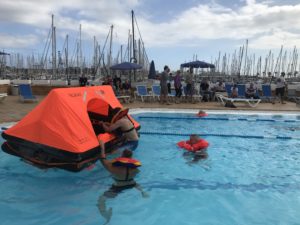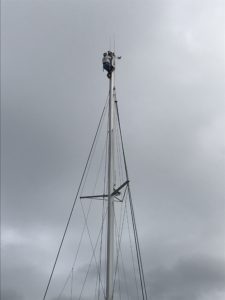The morning starts with a helicopter rescue demonstration. A real person is winched off a real sailboat just outside the harbour. Everyone stands riveted on the end of the break water probably all secretly praying that it never comes to this, as cool as it looks from the safety of the break water.
Next we move to an outdoor pool where we launch, inflate and have a chance to practice climbing into a life raft. Every boat in the race has to carry one. The life rafts inflates spontaneously, hopefully the right way up and comes complete with provisions for 6-8 people for a specified duration.

Climbing into the life raft
Later in the day the race organizers come and do a safely check on the boat. Flares, first aid kits, how many people are first aid trained? Where is the grab bag? We are reminded to put passports and cash in the grab bag at the start so we don’t have to look for them in the event of having to abandon the boat. Do you have an emergency life raft and of what type? When was it last serviced and how long is it provisioned for?
How do you cut the rigging? I never thought of that! Bolt cutters and hacksaw of course…all stored in an accessible locker in the port quarter berth. Is the keel stepped mast properly bolted to the salon floor, how many storm sails on board? Does each person have their name written inside their life jacket? Does everyone one have a three point harness integrated into the life jacket? Are the lifelines the entire length of the boat? How many flares and of what type? Do you have emergency steering? Are there softwood plugs at each through hull fitting?
What is your man overboard recovery method? Do you have a hand held sat phone? Do you have paper charts? The list goes on and on until every inch of the boat and safety gear is inspected and understood. This was a really helpful process given that 10 hours ago I hadn’t stepped foot on this boat.
Later I am tasked with doing an engine check using the WOBLE (water, oil, belts, leaks and electrical) method and get my first crash course in diesel mechanics. I top up the oil and tighten the belt. Of course we will not use the engine between here and St Lucia but need to ensure it is ready on the case of an emergency. It may be run in neutral if our solar panels don’t generate enough power.
Another of the crew is sent up the mast to inspect the top of the mast and change a bulb.

A long way up to change a light bulb.
Safely checks are done and we spend the rest of the day working through the other items on our to do list.
As much as I always enjoy hanging out at marinas I am keen to get the race underway and get out to sea.
The description is clear and inspiring. It’s been a while since this old body has been on that kind of edge. Humourous, a wisp of dread, pure anticipation. Recalling the breath. Way to go.
Wow…you have been busy! Bon voyage my friend! Looking forward to your next post.